MetaVR creates 3D real-time environments that provide the fidelity of geospecific simulation with game quality graphics and performance.
In this issue:
54.A – QuantaDyn delivers MetaVR based JTAC simulators to multiple European sites
54.B – Air Force Pilot Training Next program takes delivery of MetaVR based simulators
54.C – MetaVR visuals in new F-16 simulators at Tucson Air National Guard Base
54.D – AFRL at Wright Patterson AFB purchase 24 new VRSG licenses for F-16 simulators
54.E – Luke Air Force Base renews 62 VRSG software maintenance licenses for F-16 FMTs
54.F – MetaVR visuals in JTAC portable simulators for the ROK Army Special Warfare School
54.G – A-10 FMT software maintenance renewal for 384 VRSG licenses
54.H – BOSS refueling simulator renews 143 VRSG software maintenance licenses
54.I – MetaVR visuals in new simulators at Embry-Riddle Daytona Beach campus
54.J – How to obtain VRSG version 6.3
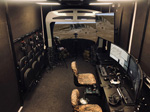
54.A QuantaDyn delivers MetaVR based JTAC simulators to multiple European sites
In recent months QuantaDyn has purchased 50 MetaVR Virtual Reality Scene Generator (VRSG) licenses to be fielded in joint terminal attack controller (JTAC) simulators at multiple training sites in Europe.
Scheduled for this month is the delivery of the QFires Advanced JTAC Training System (AJTS) to be installed at the Slovenian Armed Forces Air Ground Operations School (AGOS) at Cerklje ob Krki Airbase. The AJTS provides a high fidelity, fully-immersive environment critical for training JTACs and JFOs. QuantaDyn has also been awarded the contract to deliver and install an AJTS at the Polish Air Force Academy in Deblin, Poland. The AJTS dome training system uses the same underlying technology as several U.S. accredited JTAC programs including the USAF's JTC TRS and U.S. Air National Guard's AAJTS; MetaVR VRSG and 3D content, Battlespace Simulations' (BSI's) Modern Air Combat Environment (MACE), and a dome display from Immersive Display Solutions (IDSI) for rendering the immersive environment. The AJTS supports terminal control, terminal guidance, close air support, call for fire, and joint fires operations.
Last month QuantaDyn announced it will deliver six QFires desktop and portable JTAC training systems to the United States Air Force Europe (USAFE) Warrior Preparation Center (WPC) in Einsiedlerhof Air Station, Germany. The delivery includes four QFires DT-100 Desktop systems and two PT-100 Portable systems. As with QuantaDyn's larger JTAC systems, the DT-100 desktop systems are accredited by the Joint Fire Support Executive Steering Committee (JFS ESC) as required for JTAC qualification and currency training IAW the JTAC MOA. With 78 VRSG licenses, the USAFE at WPC has long used MetaVR visuals in JTAC, F-16, remotely piloted aircrafts (RPAs), and other training missions. This QuantaDyn announcement follows their installation of a JTC TRS dome simulator at the WPC in late 2017, and described in the MetaVR newsletter Issue 52.
MetaVR visuals are also part of the initial configuration of the new Joint Fires Mobile Trainer (JFMT) in use by the UK Ministry of Defense for the British Army's 1st Artillery Brigade. For this contract Elbit Systems UK is the prime contractor and is partnered with QuantaDyn to provide a managed training service. The training classroom is completely self-contained within a 20 ft. trailer, and uses the same underlying technology as the abovementioned installations. This system uses IDSI's new VisionStation 3 to render an immersive virtual environment. The setup includes a student station with a full suite of simulated military equipment, an instructor/operator station, a pilot or role player station, and a mission brief/after action review station suitable for a team of four. Like the QuantaDyn systems on which this system is based, this new mobile JTAC training facility provides fully accredited training for Type 1, 2, and 3 day and night close air support control; laser designation and call for fire training. QuantaDyn is the developer and integrator of the JFMT system.
Over the past five years, QuantaDyn has provided the largest number of close-air-support simulation systems fielded in the U.S. and abroad, in their accredited joint fires devices, which range from portable and desktop systems to immersive domes for JTAC training.
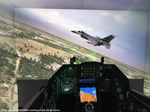
54.B Air Force Pilot Training Next program takes delivery of MetaVR based simulators
As part for the Pilot Training Next (PTN) initiative, the U.S. Air Force recently took delivery of two F-16C simulators at Kelly Field, Lackland Air Force Base that use MetaVR 3D real-time graphics, terrain, and 3D models that comprise an immersive virtual cockpit for training student pilots. Housed in a relocatable shelter, the 2-ship simulators use a total of 30 MetaVR virtual reality scene generator (VRSG) channels for simulating the out-the-window, embedded HUD, HMD/HMIT, real time streaming protocol (RTSP) in the central display unit (CDU), ground map radar, targeting pod, and maverick missile displays. We believe that for the first time, the 149th Fighter Wing unit has an F-16C Block 30 simulator that matches the current aircraft configuration such that it is concurrent with the hardware and software of the actual aircraft F-16C Block 30 System Capabilities Upgrade 9.0 standard. This concurrency is essential for training new student pilots such that the students train in a simulator that represents their block 30 primary F-16 training platforms.
Included in the 3D terrain is MetaVR's virtual replica of Lackland Air Force Base, (KSKF), which was built from 15 cm per-pixel source imagery of the of Lackland Air Force Base and Greater San Antonio blended into 1 mpp underlying imagery of our CONUS++ terrain. The terrain's elevation was built with interpolated NED 1/3 (10 mpp) of Lackland AFB and DTED 1 of San Antonio, blended into underlying DTED 1 data. The round-earth terrain was built with Terrain Tools for Esri ArcGIS. Culture models of the geospecific control tower and other structures were placed with MetaVR Scenario Editor.
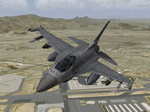
54.C MetaVR visuals in new F-16 simulators at Tucson Air National Guard Base
The 162nd Fighter Wing of the Arizona Air National Guard recently took delivery of two reconfigurable flight simulators capable of representing either an F-16C block 30 SCU 9.0 or a block 40 M7.1 actual aircraft. The training devices incorporate a total of 30 channels of VRSG, 3D terrain, and 3D models. Pilots began training on the simulators this week at the Tucson Air National Guard Base, Arizona. Each simulator uses fifteen VRSG channels in an immersive virtual cockpit to simulate multiple views: out-the-window, embedded HUD, HMD/HMIT, real-time streaming protocol (RTSP) in the central display unit (CDU), ground map radar, targeting pod, and maverick missile displays. These F-16 simulators have the same configuration as the ones also recently delivered to Kelly Field, Lackland AFB, described in item #54.B.
Included in the 3D terrain is MetaVR's virtual replica of Tucson International Airport (KTUS), which was built from 15 cm per-pixel source imagery of the airfield area blended into 1 mpp underlying imagery of our CONUS++ terrain. The terrain's elevation was built with interpolated NED 1/3 (10 mpp) blended into underlying DTED 1 data. The round-earth terrain was built with our Terrain Tools for Esri ArcGIS. Culture models of the geospecific control tower and other structures were placed with MetaVR Scenario Editor.
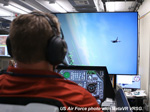
54.D AFRL at Wright Patterson AFB purchase 24 new VRSG licenses for F-16 simulators
The Secure Live Virtual Constructive, Advanced Training Environment (SLATE) program of the Air Force Research Laboratory's (AFRL) Warfighter Readiness Research Division 711th Human Performance Wing (711HPW/RHA) at Wright Patterson Air Force Base (WPAFB) is using some of its 24 newly acquired MetaVR Virtual Reality Scene Generator (VRSG) real-time 3D rendering licenses to simulate F-16 aircraft. While combining synthetic and real-world air combat training, SLATE has demonstrated an LVC training capability that will enable pilots to train as they fight against realistic threats while in a secure, high-fidelity environment.
AFRL uses a total of 181 VRSG software licenses in multiple simulator test-bed programs. AFRL at WPAFB has long used VRSG for training research simulators ranging from the MQ-1/MQ-9 Remotely Piloted Aircraft (PRINCE), to F-16 tactical trainers, to the JTAC Training and Rehearsal System.
This past September, SLATE concluded a 40-month effort with a Phase III capstone demonstration at Nellis Air Force Base. The three phases demonstrated technical capabilities to reduce risk for LVC as a future readiness concept. This final phase featured live USAF F-15E and U.S. Navy F/A-18F aircraft, virtual F-16 and F/A-18 simulators, and constructive computer-generated entities.
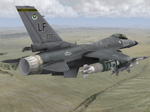
54.E Luke Air Force Base renews 62 VRSG software maintenance licenses for F-16 FMTs
Luke Air Force Base (AFB) in Glendale, AZ, recently renewed software maintenance for 62 VRSG licenses and one MetaVR Terrain Tools for Esri ArcGIS license for their F-16C Block 30/40 full-mission training simulators at the base's Network Training Center facility. Each dome-based multi-channel simulator contains a full cockpit replica of an actual F-16C, with VRSG rendering out-the-window (OTW) and sensor views. As part of the initial VRSG delivery in 2010, MetaVR built and delivered a high-fidelity geospecific replica of Luke Air Force Base (KLUF) and the Barry M. Goldwater Range (BMGR) with the East Tactical Range (ETAC) airfield with geographically located 3D models of all of the range targets. The terrain was built from 0.30 meters-per-pixel (mpp) resolution imagery of Luke AFB, and 0.50 mpp imagery of BMGR, all blended into 1 mpp underlying imagery of MetaVR's CONUS++ terrain. The round-earth Metadesic format terrain was built with MetaVR Terrain Tools.
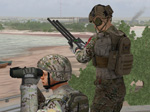
54.F MetaVR visuals in JTAC portable simulators for the ROK Army Special Warfare School
Battlespace Simulations (BSI) has been awarded an order by GB International to deliver two JTAC portable COTS simulators to the Republic of Korea (ROK) Army Special Warfare School that include eight VRSG licenses, terrain, and models. 3D terrain of the entire Korean peninsula in MetaVR's round-earth Metadesic format will be provided by a collaborative effort between the Simulator Database Repository at Kirtland Air Force Base and the Joint Close Air Support (JCAS) Section of the Joint Staff, Joint Fires J6 division. The BSI JTAC simulators will include an Instructor Station, Student Station, communications suite (with radios, ROVER feed, Defense Advanced GPS Receiver (DAGR)), and a BSI-developed emulated Laser Target Designator to provide the ROK a JTAC training system currently in use by U.S. and NATO forces. The simulator is designed for a classroom setup or a configuration that can easily transition to custom ruggedized cases for use in the field. The ROK JTAC simulator will use BSI's MACE, Viper DIS radio, and Worldwide Open Street Map software, and Close Air Solutions' C-EAGR emulated DAGR software.
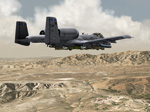
54.G A-10 FMT software maintenance renewal for 384 VRSG licenses
The U.S. Air Force (USAF) recently renewed 384 VRSG licenses and five Terrain Tools licenses for the A-10 Full Mission Trainer (FMT) program. Since 2001, MetaVR has been the primary supplier of 3D real-time visuals for the A-10 Full Mission Trainer (FMT) used in the A-10 Aircrew Training System. The USAF uses VRSG to equip new and existing sites with networked training systems that train U.S. pilots for close air support missions in conjunction with JTAC simulators.
An A-10 FMT uses MetaVR visuals for the out-the-window and sensor views and consists of a high-fidelity replica of an A-10 aircraft cockpit, an Instructor Operator Station, a visual system and other equipment that provides trainees initial and ongoing training for flight, mission, and tactics.
Ten sites have one or more MetaVR-based A-10 FMT simulators: Baltimore Air National Guard Base (ANGB), MD, Barksdale Air Force Base (AFB), LA, Boise ANGB, Gowan Field, ID, Davis-Monthan AFB, AZ, Ft. Smith ANGB, AR, Ft. Wayne ANGB, IN, Moody AFB, GA, Osan AB, Korea, Selfridge ANGB, MI, and Whiteman AFB, MO.
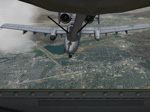
54.H BOSS refueling simulator renews 143 VRSG software maintenance licenses
The Air National Guard (ANG) recently renewed software maintenance for 143 VRSG real-time licenses used in the KC-135R Boom Operator Simulator System (BOSS) at ANG sites across the U.S.
The BOSS includes a high-fidelity replica of a KC-135R Block 40 boom pod, and has been certified by the U.S. Air Force for boom operator training missions in lieu of actual flight time. The system also includes a desktop MicroBOSS trainer. MetaVR has been the image generator provider for the Distributed Mission Operations (DMO)-capable refueling boom operator trainer since 2013.
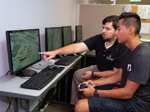
54.I MetaVR visuals in new simulators at Embry-Riddle Daytona Beach campus
Embry-Riddle Aeronautical University Daytona Beach campus installed eight VRSG desktop systems this fall to upgrade and expand the simulation capabilities of its UAS training lab.
A key feature of these new simulators is that VRSG can be driven by the Piccolo Command Center Interface Software, via a VRSG plugin developed by Georgia Tech Research Institute (GTRI), which uses MetaVR's CIGI interface. (The Piccolo software is a widely fielded commercial UAS ground control station software application.)
The UAS lab aims to eventually collect imagery from its own UAS for the purpose of using it to build 3D terrain in MetaVR Terrain Tools for Esri ArcGIS and have VRSG render the terrain in the UAS simulators. Embry-Riddle is one of a few universities in the United States US to offer a Bachelor of Science degree in UAS Science, and the first UAS accredited program in the country. The curriculum offers both state-of-the-art simulation and in-field flight experience, enabling students to operate unmanned aircraft in both virtual and actual environments, fly UAS missions as part of a crew, and develop a strong foundation of aviation fundamentals.
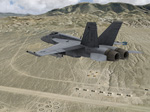
54.J How to obtain VRSG version 6.3
MetaVR customers on active maintenance can download the latest release of VRSG version 6.3 software and model libraries from MetaVR's Download Server. The release is organized in multiple components on the Download Server to facilitate customized updates. Customers on active maintenance can request an account on MetaVR's Download Server by sending a request to downloads@metavr.com.
The full VRSG 6.3 release is compressed to nearly 79 GB in size and can also be delivered on a Blu-ray disc. As a courtesy, MetaVR will provide at no charge, a Blu-ray reader device to facilitate the latest installation.
You can check the VRSG Dashboard's About tab to determine the maintenance status of a VRSG license. Annual software maintenance is $1,500 USD per single viewport license and can be purchased on the MetaVR website by clicking "How to Buy" or by sending a formal request for quotation with your MetaVR dongle ID to sales@metavr.com.
MetaVR continues to implement customer-requested software features at no additional cost beyond the license purchase and the annual software maintenance fees. Many features in the VRSG version 6.3 release were developed as the result of customers' requests, at no additional charge.
This historical, archived newsletter contains the previous name of our company. Our company name is now MVRsimulation, per our announcement of September 1, 2021.
Previous issues of MVRsimulation News can be found at www.mvrsimulation.com/aboutus/newsarchive.html.
Copyright © 2018-2021, MVRsimulation Inc.
